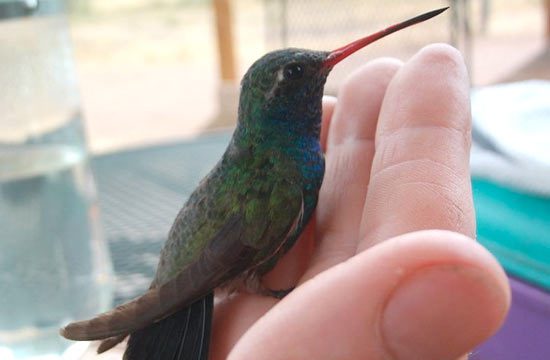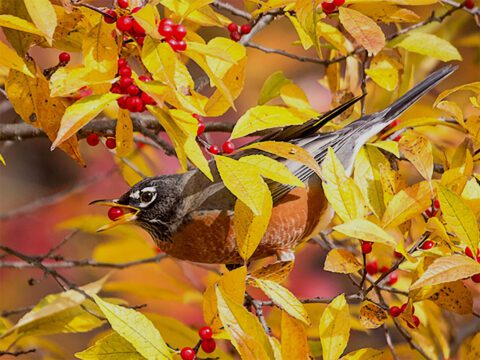Feeder relief for Arizona’s fire-stricken hummingbirds
July 27, 2011
Broad-billed Hummingbirds are coming to feeders in much higher numbers than usual. 
At banding demonstrations, SABO gives out feeders to help people provide food for displaced hummingbirds. (Violet-crowned Hummingbird). 
Lucifer Hummingbirds are among 11 species regularly seen in Southeast Arizona. 
A flare-up in the Huachuca Mountains on June 14 was visible from 22 miles away.. 
Extreme drought led to widespread fires in June and July, burning entire slopes in some cases.
In a year that started with six of southeastern Arizona’s driest months on record, wildfires have burned nearly a million acres of mountain forests in the state. Though fire is an integral part of this western ecosystem, the burned areas are so large this year that the region’s incredible diversity of hummingbirds may be short of food in the next few months, some people worry. But there may be a few small ways for interested birders to help.
The fires are out now, thanks to the arrival of the late-summer monsoons. But over large areas, burned forests now offer much less understory and fewer hummingbird flowers. In what looks like a direct result of missing natural food sources, hummingbirds are being seen in unusually high numbers around towns, according to Sheri Williamson, director of the Southeastern Arizona Bird Observatory (SABO) in Bisbee, Arizona. As we talked, she said, her feeder garden was a chaos of Rufous and Black-chinned Hummingbirds.
“We might not be able to help warblers, flycatchers, birds of prey, and bears and things like that,” Williamson said. “But we can help hummingbirds.” She encourages locals to put out extra feeders and has secured a grant from Kaytee to give away hummingbird feeding kits to people who want to help. (Kaytee is a sponsor of the Cornell Lab.)
“There have been huge influxes of birds to feeding stations,” Williamson said. “Broad-billed Hummingbirds normally nest up in the foothill canyons. They normally do not occur in large numbers along the San Pedro River, but we have had many, many broad-bills. We’re even seeing Magnificent Hummingbirds in the outskirts of Sierra Vista, and they are a mountain hummingbird—they want to be in pine-oak woodland,” at least a thousand feet higher up.
Williamson said she’s not worried about the long-term prospects of the hummingbirds—the forest and its understory will recover. “But we are coming into peak hummingbird migration season in the next few weeks,” she said. “I’ve got a yard full of Rufous Hummingbirds right now and it’s only going to get worse.” She noted that she has seven hummingbird feeders in her yard—about three times the number she usually has this time of year.
Southeastern Arizona has a spectacular assortment of hummingbirds—as many as 14 species have been seen in a single day. From now until early October, the breeding species will be joined by thousands of migrating Rufous, Calliope, Broad-tailed, and Black-chinned Hummingbirds. During past drought years, Williamson said the observatory’s banding data suggest some migrants alter their route to find greener land. “But with a [more localized] problem like a fire,” she said, “a lot of birds are just going to arrive on their normal stopover sites and find them uninhabitable.”
Williamson has a few suggestions for people who want to help ease the burden on hummingbirds:
- Locals who don’t presently feed hummingbirds can start feeding them, and people who already do can add feeders for the next few months
- Through the grant from Kaytee, SABO will be giving away up to $50,000 worth of hummingbird feeders and an electrolyte-enhanced hummingbird food at farmers markets and banding demonstrations. Check the SABO news page for giveaway dates and locations
- People who aren’t in southeastern Arizona but want to help will soon be able to sponsor a Kaytee kit giveaway by purchasing the package, for a reduced price, via Amazon. Check Kaytee’s Arizona Hummingbird Disaster Relief site for details
- Donations to the Southeastern Arizona Bird Observatory, via their website, will help them in their work
- People can still attend the Southwest Wings Birding and Nature Festival next week (August 3–7) in Sierra Vista, Arizona, where they can learn more about the fires and still have great birding opportunities while supporting local businesses
- Coloradoans, Utahans, and others who live farther north along migration routes could try supplying more hummingbird food than usual. “Feed those birds well so they’re nice and fat when they take off,” Williamson said, “Maybe that’ll give them a little bit of a cushion.”
As severe as the fires have been, Williamson stresses that the forests would be worse off without the periodic burns that they evolved with every 6 to 10 years. This year’s fires are especially severe because of the region’s long drought and a buildup of fuel that comes, paradoxically, from decades spent trying to put out fires as soon as they started.
“Things rot where you live [in the East],” she told me. “Things don’t rot here. It takes fire to recycle a lot of our dead plant material. It still is an emotional thing to see a 200-year-old alligator juniper go up like a match. Things are going to eventually be much better for hummingbirds than they have been. But for a while—weeks, months, maybe a couple of years—things are going to be hard.”
Images courtesy Sheri Williamson/Southeastern Arizona Bird Observatory.

All About Birds
is a free resource
Available for everyone,
funded by donors like you
American Kestrel by Blair Dudeck / Macaulay Library









